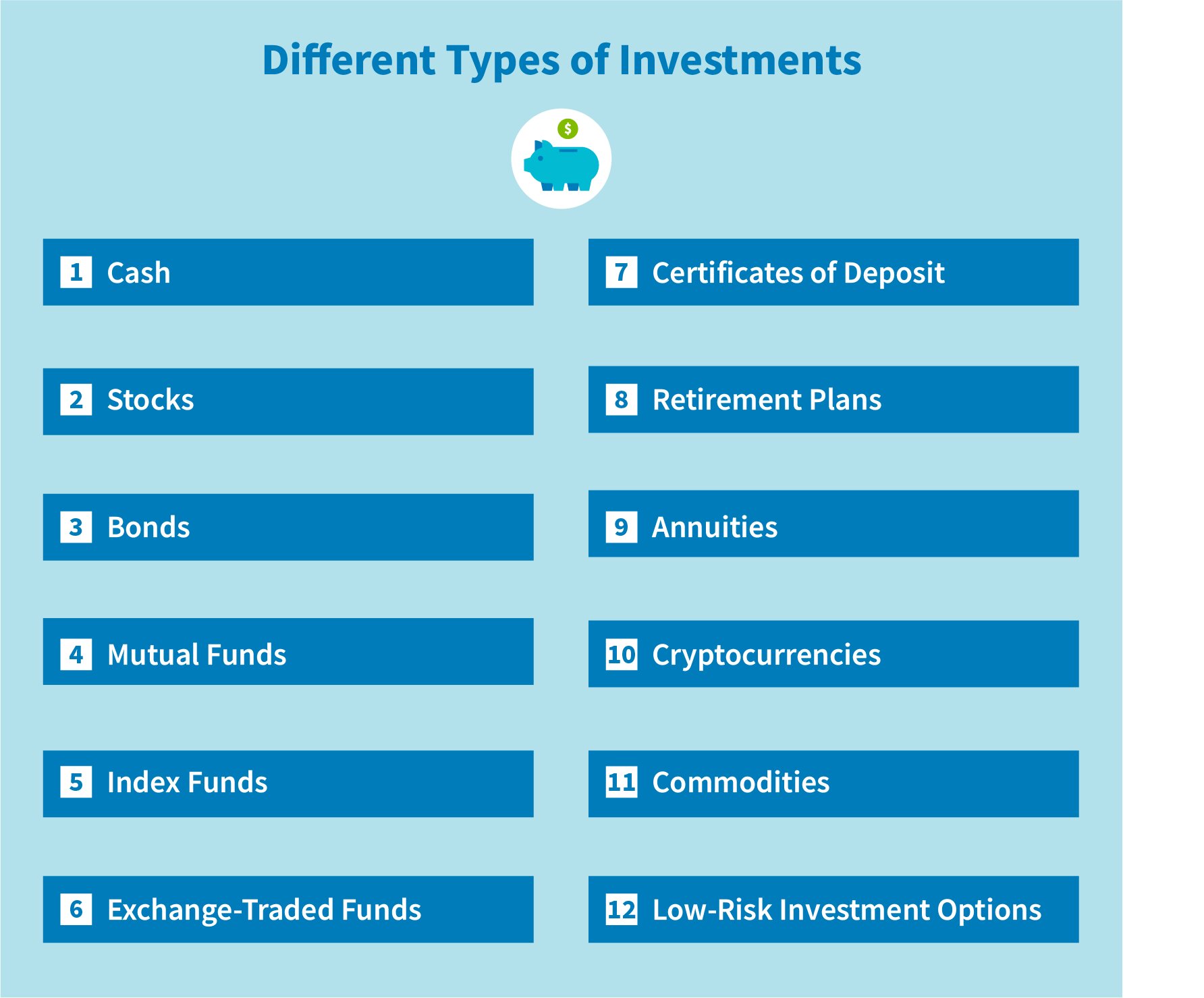Introduction
Investing in the stock market has long been considered one of the most effective ways to build wealth over time. Whether you’re a seasoned investor or just dipping your toes into the world of stocks, understanding how to leverage your investments is crucial for maximizing your returns.
In this comprehensive guide, we will explore various strategies and techniques to help you make informed decisions and optimize your stock investments. From choosing the right stocks to managing risks, reading financial statements, and setting financial goals, we will cover all the essential aspects of successfully leveraging your stock investments.
It’s important to note that investing in stocks comes with inherent risks, and there are no guaranteed returns. However, by equipping yourself with the necessary knowledge and employing smart investment strategies, you can increase your chances of achieving financial success.
Whether your goal is to grow your nest egg, save for retirement, or generate passive income, this guide will provide you with the insights and tools you need to navigate the stock market with confidence.
So, if you’re ready to take your stock investments to the next level, let’s dive in and discover how to leverage your investments effectively.
Understanding the Basics
Before diving into the world of stock investing, it’s important to have a solid understanding of the basics. Stocks represent ownership shares in a company, and when you invest in stocks, you become a shareholder with a stake in the company’s success.
One key concept to grasp is the difference between stocks and other investment vehicles, such as bonds or mutual funds. While bonds offer fixed interest payments and mutual funds pool investors’ money to invest in a diversified portfolio, stocks provide the potential for higher returns but also involve greater risks.
Another fundamental aspect to understand is the stock market itself. The stock market is a platform where buyers and sellers trade stocks. Major stock exchanges, such as the New York Stock Exchange (NYSE) or the NASDAQ, facilitate these transactions.
Stock prices are determined by the forces of supply and demand. As more people want to buy a particular stock, the price typically increases, whereas increased selling pressure tends to decrease the price. Factors that influence stock prices include company performance, economic conditions, industry trends, and investor sentiment.
Additionally, it’s essential to differentiate between two types of stocks: common stocks and preferred stocks. Common stocks offer ownership rights and voting privileges, while preferred stocks typically provide higher dividend payouts but may lack voting rights.
Investors should also be aware of different investment styles, such as value investing or growth investing. Value investors focus on finding undervalued stocks trading below their intrinsic value, while growth investors seek companies with high growth potential, even if their current valuations are relatively high.
Finally, it’s crucial to be familiar with key financial ratios and metrics, such as price-to-earnings (P/E) ratio, earnings per share (EPS), and return on equity (ROE). These indicators can help evaluate a company’s financial health and performance.
By understanding the basics of stocks, the stock market, investment styles, and financial metrics, you will be better equipped to make informed decisions about your investments. With this foundation in place, let’s move on to exploring how to choose the right stocks for your portfolio.
Choosing the Right Stocks
Choosing the right stocks is a crucial step in leveraging your stock investments effectively. While there is no one-size-fits-all approach, several strategies can help you identify promising companies and build a diversified portfolio.
One popular method is fundamental analysis, which involves assessing a company’s financial health, competitive position, management team, and growth prospects. By conducting thorough research and analyzing financial statements, including balance sheets, income statements, and cash flow statements, you can gain insights into a company’s profitability, debt levels, and cash flow generation.
Another approach is to consider macroeconomic factors and industry trends. For example, you may look for stocks in sectors that are expected to experience rapid growth or benefit from emerging trends, such as renewable energy, technology, or healthcare. Keeping an eye on market news and staying informed about global events can help you spot investment opportunities.
Investors should also consider their risk tolerance and investment timeframe. Stocks can be volatile, and it’s important to align your investments with your financial goals and risk tolerance. Long-term investors may focus on stable, dividend-paying companies, while more aggressive investors may seek growth stocks with higher potential but also higher risk.
Diversification is another key component of selecting the right stocks. Building a well-diversified portfolio helps spread risk and reduces the impact of any single stock’s performance on your overall investment. Allocating investments across various sectors, industries, and geographical regions can help protect your portfolio from market fluctuations.
Furthermore, it can be beneficial to pay attention to other investors’ insights and recommendations. Analyst reports, expert opinions, and online communities can provide valuable perspectives, but it’s important to conduct your own thorough research and make independent decisions.
Lastly, keep in mind that investing in stocks requires ongoing monitoring and adjustments. Regularly evaluating your portfolio’s performance and making necessary changes based on changing market conditions or your financial goals is essential for long-term success.
By considering fundamental analysis, market trends, risk tolerance, diversification, and continuous monitoring, you can effectively choose the right stocks that align with your investment objectives. Next, let’s explore strategies for managing risk and diversification in your stock portfolio.
Diversification and Risk Management
Diversification and risk management are critical aspects of maximizing the potential returns and minimizing potential losses in your stock portfolio. By spreading your investments across different asset classes, sectors, and geographical regions, you can reduce the impact of any single investment’s performance on your overall portfolio.
One way to achieve diversification is through investing in different industry sectors. By holding stocks from various sectors, such as technology, healthcare, finance, and consumer goods, you can mitigate the impact of sector-specific risks. This approach helps ensure that a downturn in one sector does not severely impact your entire portfolio.
Geographical diversification is equally important. Investing in companies from different regions and countries can help you take advantage of global economic growth opportunities while reducing the risk associated with any one country’s economy or political environment. Consider allocating a portion of your portfolio to international stocks or mutual funds that offer exposure to a diverse range of global markets.
Another way to diversify is by including different types of assets in your portfolio. Alongside stocks, you may consider including bonds, real estate investment trusts (REITs), or exchange-traded funds (ETFs). These alternative assets can provide stability and income streams that may offset potential volatility in stock investments.
Risk management is also essential in stock investing. One crucial principle is to set a stop-loss order, which automatically sells a stock if it reaches a predetermined price level. This helps limit potential losses if a stock’s price declines unexpectedly.
Additionally, monitoring and adjusting your portfolio regularly is crucial for effective risk management. Keeping an eye on your investments and taking appropriate action when needed can help you stay on track with your financial goals and respond to changes in market conditions promptly.
It’s important to note that even with diversification and risk management strategies in place, investing in stocks always carries some level of risk. Therefore, thoroughly researching and understanding the companies you invest in, staying informed about economic and market trends, and having a long-term perspective are essential components of successful risk management.
By diversifying your portfolio across sectors, regions, and asset classes, setting stop-loss orders, and staying vigilant with monitoring and adjustments, you can effectively manage risk and optimize the potential returns in your stock investments. Next, we will delve into the importance of fundamental analysis in evaluating stocks.
Fundamental Analysis
Fundamental analysis is a crucial tool for evaluating stocks and making informed investment decisions. It involves examining a company’s financial performance, industry position, management team, competitive advantages, and growth prospects to determine its intrinsic value and potential for future success.
One key aspect of fundamental analysis is assessing a company’s financial statements. These statements, including the balance sheet, income statement, and cash flow statement, provide insights into the company’s revenue, expenses, assets, liabilities, and cash flows. By analyzing these financial indicators, investors can gauge a company’s profitability, liquidity, and financial health.
Another important consideration is the competitive landscape. Understanding a company’s position within its industry, its market share, and its competitive advantages is crucial. This analysis involves studying industry trends, competitors, and the company’s unique value proposition. Evaluating a company’s ability to maintain a competitive edge is essential for long-term success.
The quality of a company’s management team is also a significant factor to consider. Examining the leadership’s track record, experience, and strategic decision-making abilities helps assess the company’s direction and execution capabilities. Additionally, analyzing a company’s corporate governance practices and transparency can provide further confidence in management’s integrity and decision-making process.
Furthermore, fundamental analysis includes evaluating a company’s growth prospects. This analysis involves assessing the company’s market opportunities, product or service innovations, and potential for expanding into new markets. Understanding the company’s growth trajectory can provide insights into its future earnings potential and long-term value.
Other factors to consider in fundamental analysis include the company’s dividend policy, debt levels, and valuation metrics. Dividend-paying companies may be of interest to income-oriented investors, while low debt levels and attractive valuation ratios can indicate financial stability and potential for stock price appreciation.
It’s important to note that fundamental analysis requires thorough research, careful attention to detail, and an understanding of industry dynamics. It is a constantly evolving process, as economic conditions, market trends, and company-specific factors change over time. Regularly reviewing and updating your analysis is crucial for maintaining a well-informed investment approach.
By employing fundamental analysis techniques, investors can gain insights into a company’s financial health, industry position, management quality, and growth potential. This analysis serves as a foundation for making informed investment decisions and aligning your portfolio with your financial goals. In the next section, we will explore the complementary approach of technical analysis in stock investing.
Technical Analysis
While fundamental analysis focuses on evaluating a company’s financials and intrinsic value, technical analysis takes a different approach by examining historical price and volume data to predict future stock price movements. It is based on the belief that stock market trends repeat themselves and that past price and volume patterns can provide insights into future market behavior.
Charting is a common technique in technical analysis. Traders and analysts use various types of charts, such as line charts, bar charts, and candlestick charts, to visualize price patterns and identify trends. These charts display historical price data, including open, high, low, and closing prices, over a specified time frame.
One key concept in technical analysis is support and resistance levels. Support levels are price levels at which there is historically buying support, preventing the stock price from declining further. Resistance levels, on the other hand, are price levels at which selling pressure historically prevents the stock price from rising above that level. By identifying these levels, traders can make decisions about when to buy or sell a stock.
Another tool used in technical analysis is indicators. These mathematical calculations are applied to the price and volume data to provide additional insights into market trends. Examples of popular technical indicators include moving averages, relative strength index (RSI), and MACD (Moving Average Convergence Divergence). These indicators can help identify potential entry or exit points in the market.
Chart patterns are also significant in technical analysis. Patterns, such as head and shoulders, double tops, and ascending triangles, can indicate potential reversals or continuations in the stock’s price trend. Recognizing and interpreting these patterns can assist traders in making trading decisions.
It’s important to note that technical analysis is not foolproof and should not be used as the sole basis for investment decisions. It is most commonly utilized by short-term traders and investors who aim to capitalize on short-term price movements. Long-term investors may use technical analysis as a complement to their fundamental analysis to confirm or supplement their investment thesis.
Keeping up with market news and developments is also essential in technical analysis. Economic indicators, company announcements, and geopolitical events can significantly impact stock prices, and technical analysts incorporate this information into their analysis to make informed trading decisions.
By combining technical analysis with fundamental analysis and staying informed about market news, investors can gain a holistic perspective and make well-informed investment decisions. In the next section, we will discuss the importance of reading and understanding financial statements when evaluating stocks.
Reading Financial Statements
Reading and understanding financial statements is a fundamental skill for any investor looking to make informed decisions about stocks. Financial statements provide a snapshot of a company’s financial health and performance, allowing investors to assess its profitability, liquidity, and overall stability.
There are three primary types of financial statements – the balance sheet, income statement, and cash flow statement.
The balance sheet provides a summary of a company’s assets, liabilities, and shareholders’ equity at a specific point in time. It gives insights into the company’s financial position, including its ability to meet short-term and long-term obligations. Key elements on the balance sheet include current assets (such as cash, accounts receivable), fixed assets (such as property, plant, and equipment), current liabilities (such as accounts payable, short-term debt), and long-term liabilities (such as long-term debt).
The income statement, also known as the profit and loss statement, shows a company’s revenue, expenses, and its net profit or loss over a specific period. It helps investors understand a company’s revenue sources, cost structure, and profitability. Key components of the income statement include revenues, cost of goods sold, operating expenses, and interest and taxes.
The cash flow statement provides information about a company’s cash inflows and outflows during a specific period. It breaks down the sources and uses of cash, including operating activities, investing activities, and financing activities. It helps investors assess a company’s liquidity and ability to generate cash.
By analyzing these financial statements, investors can calculate various financial ratios and metrics to gain deeper insights into a company’s financial performance. Key ratios include the price-to-earnings (P/E) ratio, return on equity (ROE), earnings per share (EPS), and debt-to-equity ratio. These ratios can be compared to industry averages or historical trends to evaluate a company’s financial health and profitability.
In addition to the financial statements, the accompanying notes to the financial statements provide additional information and explanations about specific accounting policies, contingent liabilities, and other relevant details. It is crucial to read and understand these notes to obtain a comprehensive understanding of a company’s financial position.
Understanding financial statements enables investors to make informed decisions about whether to invest in a company or not. By analyzing a company’s financial health and performance, investors can assess its potential for long-term growth and profitability. Moving forward, we will explore the importance of setting financial goals and creating a portfolio strategy to guide your stock investments.
Setting Financial Goals
Setting financial goals is a crucial step in leveraging your stock investments effectively and aligning them with your overall financial objectives. By defining clear and measurable goals, you can better determine the investment strategies and timeframes that are most appropriate for you.
When setting financial goals, it’s important to consider both short-term and long-term objectives. Short-term goals may include saving for a down payment on a house, paying off debt, or taking a dream vacation. Long-term goals, on the other hand, may involve saving for retirement, funding your children’s education, or building a substantial investment portfolio for financial independence.
Start by quantifying your goals. Instead of simply saying “I want to save money,” specify the amount you want to accumulate within a given timeframe. This will give you a clear target to aim for and will help you stay motivated along the way.
Next, consider the timeframe for achieving each goal. Short-term goals typically have a timeline of up to five years, while long-term goals may have a timeline of 10, 20, or more years. Understanding the timeframe allows you to choose appropriate investment vehicles and strategies that can help you reach your goals within the desired timeframe.
Additionally, consider the level of risk you are willing to take. Different investment options carry varying degrees of risk, and your risk tolerance should align with your financial goals. If your goal is to preserve capital and protect against market downturns, a more conservative investment approach, such as investing in stable dividend-paying stocks or bonds, may be suitable. If you have a longer timeframe and are comfortable with higher volatility, you may choose to invest in more growth-oriented stocks.
It’s also crucial to regularly review and reassess your financial goals. Life circumstances and priorities can change over time, and your goals should be fluid enough to adapt to these changes. Regularly evaluate your progress, adjust your goals if necessary, and refine your investment strategy as needed.
Setting financial goals provides a roadmap for your investment journey and helps you stay focused and motivated. By clearly defining your goals, considering your time horizon, risk tolerance, and regularly reviewing your progress, you can increase the likelihood of achieving your desired financial outcomes.
Next, let’s explore the importance of creating a cohesive portfolio strategy to effectively leverage your stock investments.
Creating a Portfolio Strategy
Creating a portfolio strategy is a crucial step in effectively leveraging your stock investments. It involves carefully selecting a mix of investments that align with your financial goals, risk tolerance, and investment time horizon. A well-designed portfolio strategy can help optimize returns while managing risk.
The first step in creating a portfolio strategy is asset allocation. This involves determining the percentage of your investments allocated to different asset classes, such as stocks, bonds, cash, and alternative investments. Asset allocation is based on your risk tolerance, time horizon, and investment goals. A diversified portfolio can help mitigate the impact of volatility in any one asset class and potentially provide more stable returns over time.
Within the stock portion of your portfolio, it’s important to further diversify your investments. Consider investing in companies across different sectors, industries, and geographic regions. This diversification can help reduce the impact of any single stock’s performance on the overall portfolio. Additionally, consider balancing your investments between large-cap, mid-cap, and small-cap stocks to further diversify your holdings.
Another important aspect of a portfolio strategy is rebalancing. Over time, the value of different investments within your portfolio may fluctuate, leading to an imbalance in your asset allocation. Regularly rebalancing your portfolio helps maintain your desired asset allocation and ensures that you don’t become overly concentrated in a particular asset class or investment.
Consider your time horizon when selecting investments for your portfolio strategy. For long-term goals, such as retirement, you may be able to take on more risk and invest in growth-oriented stocks. However, for short-term goals, it’s generally advisable to focus on more stable investments, such as dividend-paying stocks or fixed-income securities.
Monitoring your portfolio is crucial for the success of your strategy. Regularly review your investments and stay informed about market and economic trends. If necessary, make adjustments to your portfolio to align with changes in your financial goals, risk tolerance, or market conditions.
Finally, it’s important to note that creating a portfolio strategy doesn’t mean you should set it and forget it. Regularly reassess your financial goals, risk tolerance, and time horizon. Market conditions and personal circumstances can change, requiring adjustments to your strategy. Stay informed, seek professional advice if needed, and be willing to adapt your portfolio strategy as necessary.
By carefully considering asset allocation, diversification, rebalancing, time horizon, and regular monitoring, you can create a portfolio strategy that maximizes the potential returns from your stock investments while managing risk. In the next section, we will explore the importance of staying informed with market news to make informed investment decisions.
Staying Informed with Market News
Staying informed with market news is crucial for making informed investment decisions and effectively leveraging your stock investments. Market news provides valuable insights into macroeconomic trends, industry developments, company-specific announcements, and global events that can significantly impact stock prices.
Keeping up with market news allows you to stay connected with the broader economic landscape. Economic indicators, such as GDP growth, inflation rates, and interest rate changes, can help you understand the overall health of the economy and its potential impact on stock markets. By staying informed about key economic indicators, you can make more informed decisions about timing your investments or adjusting your portfolio strategy.
Industry news is another essential component of staying informed. Industry trends, technological advancements, regulatory changes, and competitive dynamics can significantly influence specific sectors or companies. Understanding these trends can help you identify potential investment opportunities or risks within specific industries.
Company-specific news, such as earnings reports, product launches, mergers and acquisitions, and management changes, can significantly impact stock prices. By staying informed about these developments, you can assess the implications for the companies you are invested in or identify potential investment opportunities.
Global news and geopolitical events should also be on your radar. Changes in trade policies, political stability, or economic crises in various parts of the world can have ripple effects on global markets. Staying informed about these events can help you anticipate market movements and adjust your investment strategy accordingly.
There are several ways to stay informed with market news. Traditional sources include financial news websites, newspapers, and television programs dedicated to business and finance. These sources provide in-depth analysis, expert opinions, and up-to-date information on market trends. Additionally, many financial institutions and brokerage firms offer research reports, market updates, and investment newsletters.
Social media platforms and online communities also play a significant role in disseminating market news. Following reliable financial and business news accounts on platforms like Twitter or joining investment-focused forums and communities can provide real-time updates and insights from a wide range of sources.
However, it’s essential to filter and verify the information you come across. Not all news sources are reliable or unbiased, and it’s important to consider multiple perspectives before making any investment decisions. Developing a critical mindset and conducting your own research is crucial when interpreting market news.
By actively staying informed with market news, you can make more informed investment decisions and adjust your strategy based on evolving market conditions. Combining market news with fundamental and technical analysis can help you gain a holistic view of the stock market and make well-informed choices regarding your investments.
In the next section, we will explore the importance of knowing when to buy and sell stocks.
Knowing When to Buy and Sell
Knowing when to buy and sell stocks is a critical skill for successful investing. Making well-timed decisions can help you capitalize on opportunities for growth and maximize your returns. However, it’s important to approach buying and selling with a disciplined and informed mindset.
When it comes to buying stocks, it’s crucial to focus on the underlying value of the company. A thorough analysis of the company’s financials, growth prospects, and competitive advantages can help you identify undervalued stocks and make an informed buying decision. It’s generally advisable to buy stocks when their market price is lower than their intrinsic value, as indicated by fundamental analysis.
However, it’s also important to consider the broader market conditions. Buying during market downturns or when stocks are experiencing temporary setbacks can present attractive buying opportunities. Remember the investment adage “buy low, sell high” and aim to accumulate quality stocks at reasonable prices.
On the other hand, selling stocks requires careful consideration as well. It can be tempting to sell stocks during market panics or when prices experience a temporary decline. However, it’s crucial to assess the reasons behind the decline and whether they affect the company’s long-term prospects. If the underlying fundamentals of the company haven’t changed, it may be more prudent to hold onto the stock or even consider buying more shares.
There are certain situations where selling stocks may be warranted. If the company’s financials deteriorate significantly, its competitive position weakens, or there are substantial changes in industry dynamics, it may be a signal to reevaluate your investment. Additionally, if a stock reaches your predetermined price target or has appreciated significantly, it may be appropriate to consider selling and locking in profits.
It’s important to note that emotional decision-making can often lead to poor outcomes in investing. It’s essential to make rational decisions based on careful analysis rather than being influenced by short-term market fluctuations or fear of missing out. Developing an investment strategy and sticking to it can help mitigate emotional bias.
Setting specific criteria for buying and selling, such as target price levels, stop-loss orders, or trailing stop orders, can provide a structured approach to your decision-making process. Regularly monitoring your portfolio and revisiting your investment thesis can help you make informed choices about when to buy and sell stocks.
Overall, knowing when to buy and sell stocks requires a combination of fundamental analysis, market awareness, and emotional discipline. Continuously educating yourself, staying informed with market news, and having a clear investment strategy are key pillars of successful buying and selling decisions.
In the next section, we will explore strategies for managing emotional investing, which can greatly impact investment outcomes.
Managing Emotional Investing
Managing emotions is a crucial aspect of successful investing. Emotions, such as fear and greed, can cloud judgment and lead to irrational investment decisions. Being aware of these emotions and implementing strategies to manage them is essential for long-term investment success.
One of the first steps in managing emotional investing is to create a well-defined investment plan. Establishing clear goals, investment criteria, and risk tolerance levels helps provide a framework for decision-making. Having a plan in place can help you stay focused on your long-term objectives and minimize impulsive decisions driven by short-term market fluctuations.
Additionally, it’s important to conduct thorough research and practice due diligence before making any investment decisions. Taking the time to analyze financial statements, evaluate industry trends, and understand the company’s competitive position can help build confidence and reduce anxiety about investment decisions.
Another helpful strategy is to avoid chasing market trends or attempting to time the market. Trying to predict short-term market movements often leads to emotional decision-making and can result in missed opportunities or unnecessary losses. Instead, focus on the long-term fundamentals of the investments and make informed decisions based on careful analysis.
Diversification is another valuable technique for managing emotions. By spreading your investments across different asset classes, sectors, and regions, you reduce the impact of any single investment or market downturn on your portfolio. Diversification helps smooth out volatility and can help alleviate the anxiety that can arise from having all your eggs in one basket.
Regular portfolio monitoring is crucial, but it’s important to avoid excessive trading or making frequent changes based on short-term market movements. Constantly buying and selling stocks without a solid rationale can lead to higher trading costs and negatively impact long-term returns. Stick to your investment plan unless there is a fundamental change in the company’s outlook or your investment objectives.
Seeking professional advice can also be valuable in managing emotional investing. Financial advisors can provide objective insights, offer a broader market perspective, and help you stay disciplined during turbulent market conditions. They can also serve as a sounding board and help you navigate through emotional biases and doubts.
Finally, maintaining a long-term perspective is essential. Investing is a marathon, not a sprint. Market fluctuations are part of the investing journey, and it’s important to stay focused on your long-term financial goals. Remembering the reasons why you invested in the first place and staying patient during market downturns can help you avoid making rash decisions based on short-term emotions.
By developing a solid investment plan, conducting thorough research, practicing diversification, monitoring your portfolio without excessive trading, seeking professional advice, and maintaining a long-term perspective, you can effectively manage emotional investing. Overcoming emotional biases can lead to more rational decision-making and improved investment outcomes.
In the next section, we will explore the importance of monitoring and evaluating your investments to ensure they remain aligned with your financial goals.
Monitoring and Evaluating Your Investments
Monitoring and evaluating your investments is a crucial aspect of managing your portfolio effectively. By regularly reviewing your investments, you can ensure they remain aligned with your financial goals and make necessary adjustments to optimize your returns.
One of the key components of monitoring your investments is tracking their performance. This involves reviewing the returns of individual stocks or funds in your portfolio and comparing them to relevant benchmarks. Monitoring performance helps you determine whether your investments are meeting your expectations and whether any changes need to be made.
It’s important to evaluate the performance of your investments not just in terms of absolute returns but also relative to your own financial goals and risk tolerance. A stock or fund that has underperformed the market but is still in line with your long-term objectives may not warrant immediate action. On the other hand, an investment that consistently underperforms or no longer aligns with your goals may need to be evaluated for potential changes.
In addition to performance, it’s crucial to review the fundamentals of the companies or funds you have invested in. Assessing financial statements, industry trends, and any significant company news or developments helps ensure that your investments remain sound and have the potential for future growth.
Regularly reviewing your portfolio’s asset allocation is also important. Over time, the value of different investments may change, leading to a shift in your asset allocation. Rebalancing your portfolio helps realign your investments with your desired asset allocation and manage risk. This process involves selling assets that have become overweighted and investing the proceeds into underweighted assets, according to your target allocation.
Staying informed about market news and economic trends is crucial for monitoring your investments effectively. Changes in the economy, industry dynamics, or regulatory environments can significantly impact the performance of your investments. By staying informed, you can make more informed decisions about the future prospects of your holdings and potential adjustment needs.
Regularly evaluating your investment strategy is also essential. Financial goals, risk tolerance, and market conditions change over time. Reassessing these factors and making necessary adjustments to your investment strategy helps ensure that your portfolio remains aligned with your objectives and can adapt to evolving market conditions.
Lastly, it’s important to periodically review and update your financial goals. As life circumstances change, your financial objectives may shift as well. Regularly revisiting your goals allows you to make sure your investments are aligned with your current aspirations and adjust your portfolio and strategy accordingly.
By consistently monitoring and evaluating your investments, you can make informed decisions, stay on track with your financial goals, and maximize the potential returns of your portfolio. The process of monitoring and evaluating is dynamic and should be conducted on an ongoing basis to ensure your investments remain optimized for your individual needs.
In the next section, we will explore the concept of leveraging stock options to enhance your investment strategies.
Leveraging Stock Options
Leveraging stock options is a strategy that allows investors to enhance their investment strategies by gaining exposure to stocks at a fraction of the cost of owning the actual shares. Stock options provide the right, but not the obligation, to buy or sell a specific stock at a predetermined price, known as the strike price, within a specified period.
There are two main types of stock options – call options and put options. A call option gives the holder the right to buy a stock at the strike price, while a put option gives the holder the right to sell a stock at the strike price. By utilizing options, investors can potentially profit from both rising and falling stock prices.
One common use of stock options is to speculate on the future price movements of a particular stock. For example, a trader who believes that a stock’s price will increase can buy call options instead of purchasing the actual shares. This strategy allows the trader to control a larger number of shares with a smaller investment, potentially amplifying the returns if the stock price rises.
Stock options can also be used to hedge against potential losses. Investors who hold a significant amount of a particular stock and are concerned about a price decline can purchase put options as protection. If the stock price falls below the strike price, the put option gains value, thereby offsetting the losses on the underlying shares.
Another strategy is writing covered call options. In this strategy, investors who already own a certain stock can sell call options at a strike price above the current stock price. If the stock price remains below the strike price until the option expires, the investor keeps the premium received from selling the call option. If the stock price rises above the strike price, the investor may be obligated to sell the stock at the strike price but would still earn a profit from the premium received.
It’s important to note that while stock options offer potential benefits, they also come with risks. Options have expiration dates, and if the stock price does not move in the anticipated direction before the option expires, the investor may lose the entire premium paid for the option.
Understanding the mechanics of stock options, their pricing, and how they may impact your investment strategy is crucial. It is advisable to educate yourself and seek professional advice before venturing into options trading, as it requires a good understanding of both options and the underlying stock.
By leveraging stock options, investors can gain exposure to stocks at a fraction of the cost and potentially enhance their investment strategies. However, it’s important to carefully consider the risks involved and ensure that options trading aligns with your investment goals and risk tolerance.
In the final section, we will explore converting stock gains into passive income and the importance of tax planning for stock investments.
Converting Stock Gains into Passive Income
Converting stock gains into passive income is a strategy that can provide a steady stream of cash flow from your investments. Instead of relying solely on the potential appreciation of stock prices, this approach allows you to generate regular income from the dividends or distributions received from your stock holdings.
Dividends are payments made by companies to their shareholders as a portion of their profits. These payments are typically made on a regular basis and can serve as a consistent source of income. Many established companies, especially those in sectors like utilities, consumer goods, and financials, pay regular dividends to shareholders.
Distribution income can be generated from other types of investments, such as real estate investment trusts (REITs) or master limited partnerships (MLPs). These investment vehicles pass their income generated from their underlying assets, such as rental properties or energy infrastructure, to investors in the form of regular distributions.
To convert stock gains into passive income, you need to select stocks or investment vehicles that have a history of paying dividends or distributions. Conducting thorough research and analyzing a company’s financial health, consistency of payments, and dividend history can help you identify reliable income-generating investments.
When building a portfolio for passive income, it’s important to consider diversification. Investing in a mix of different sectors or industries can help spread the risk and ensure a more secure income stream. Additionally, focusing on companies that have a track record of increasing their dividends over time, known as dividend growth stocks, can help protect against the ravages of inflation and provide potential for income growth.
It’s crucial to monitor your investments and stay informed about any changes in dividend policies or distributions. Companies may occasionally reduce or suspend their dividend payments due to financial difficulties or market conditions. Staying vigilant and regularly reviewing the financial health of the companies or investment vehicles in your portfolio can help you make informed decisions and ensure a reliable income stream.
Dividend reinvestment plans (DRIPs) can be a useful tool for converting stock gains into passive income. These plans allow shareholders to automatically reinvest their dividends back into additional shares of the company’s stock. By reinvesting dividends, you can leverage the power of compounding and potentially increase your future dividend income.
Converting stock gains into passive income requires a long-term perspective and patience. It may take time and careful planning to build a portfolio that generates substantial income. However, the benefit of passive income is that it continues to flow even if stock prices fluctuate, providing a level of financial stability and peace of mind.
In the final section, we will explore the importance of tax planning for stock investments, ensuring you maximize your returns while maintaining compliance with applicable tax laws.
Tax Planning for Stock Investments
Tax planning is a crucial aspect of managing your stock investments effectively, as it can help you optimize your returns while ensuring compliance with applicable tax laws. By understanding the tax implications of your stock investments and implementing appropriate strategies, you can potentially reduce your tax liabilities and maximize your after-tax returns.
One key consideration in tax planning for stock investments is understanding the different tax rates applied to various types of investment income. Depending on your jurisdiction, stock dividends may be subject to different tax rates than capital gains from the sale of stocks. Understanding the tax rates and applicable tax brackets can help you make informed decisions about when to receive dividends and when to sell stocks to minimize your overall tax burden.
Another important tax planning strategy is utilizing tax-advantaged accounts. Retirement accounts, such as Individual Retirement Accounts (IRAs) or 401(k) plans, offer tax advantages like tax-deferred or tax-free growth. By investing in stocks through these accounts, you can potentially postpone the payment of taxes on your investment gains until you withdraw the funds in retirement.
Capital gains tax can be a significant consideration when selling stocks. One strategy to minimize capital gains tax liability is to use tax-loss harvesting. This involves selling stocks that have declined in value to offset the capital gains from stocks that have appreciated. By strategically timing your stock sales, you may be able to realize tax savings by offsetting capital gains with capital losses.
Dividend reinvestment plans (DRIPs) can also have tax implications. If you participate in a DRIP, each dividend payment is reinvested back into additional shares of the company’s stock. While this can be an effective strategy for long-term growth, it’s important to understand that these reinvested dividends may still be subject to taxes in the year they are received, even though you did not physically receive the cash.
Consider the holding period for your stocks and take advantage of preferential tax rates for long-term capital gains. In many jurisdictions, if you hold a stock for more than a year before selling, the resulting capital gains may be subject to a lower tax rate compared to short-term capital gains (stocks held for less than a year). Understanding the holding period and corresponding tax rates can help you plan your investment timeline accordingly.
Consulting with a tax professional or financial advisor who specializes in tax planning can be immensely valuable. They can help you navigate the complexities of the tax code, identify potential tax deductions or credits, and develop a customized tax plan tailored to your specific situation and investment goals.
It’s important to note that tax laws and regulations can change over time, so staying informed about any updates or amendments is crucial. Regularly reviewing and adjusting your tax planning strategies as necessary can help you stay compliant and make the most of your stock investments.
By implementing effective tax planning strategies, you can potentially reduce your tax liabilities and maximize your after-tax returns on stock investments. Taking a proactive approach to tax planning can significantly impact your overall investment performance and help you achieve your financial goals.
Final Thoughts
Investing in stocks can be a rewarding endeavor that allows you to grow wealth and achieve your financial goals. By leveraging your stock investments effectively, you can optimize your returns and create a solid foundation for your financial future.
Throughout this guide, we have explored various strategies and concepts to help you navigate the world of stock investments. From understanding the basics of stocks and the stock market to choosing the right stocks, managing risk, and leveraging stock options, each aspect plays a crucial role in your investment journey.
Remember, knowledge is key. Continuously educate yourself about the stock market, investment strategies, and economic trends. Stay informed with market news, monitor your investments, and regularly evaluate your portfolio to ensure it remains aligned with your financial goals.
Managing emotions is another critical element of successful investing. Avoid being swayed by short-term market fluctuations or succumbing to emotional biases. Stick to your investment plan, practice discipline, and make rational decisions based on careful analysis.
Tax planning is an essential component of managing your stock investments. Understanding the tax implications of your investments, utilizing tax-advantaged accounts, and implementing strategies to minimize tax liabilities can significantly impact your after-tax returns.
Lastly, it’s important to remember that investing involves risk. No investment is without its potential pitfalls. Be mindful of the risks associated with stocks and diversify your portfolio to spread risk across different assets, sectors, and regions.
As you embark on your stock investing journey, remember that it is a long-term endeavor. It requires patience, perseverance, and a commitment to staying informed and adapting to changing market conditions.
Always conduct thorough research, seek professional advice if needed, and make informed decisions that align with your financial goals and risk tolerance. Remember, investing is a personal journey, and what works for one person may not work for another.
By following the principles and strategies outlined in this guide, you can effectively leverage your stock investments and increase your chances of achieving long-term financial success.
Now, armed with this knowledge, it’s time to embark on your stock investing journey with confidence and make strides towards building a prosperous financial future.

























